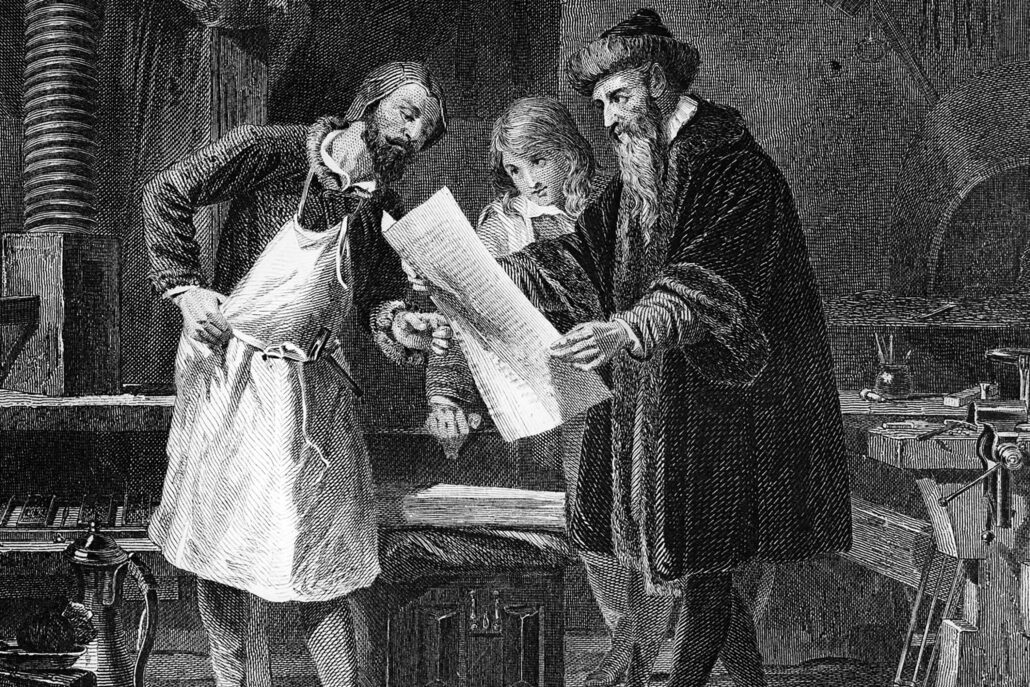Print & Publish
Printing is a process for reproducing text and image, typically with ink on paper using a printing press. Publishing is the process of production and dissemination of literature or information, available for public view.
“Some books are to be tasted, other are to be swallowed, and some few to be chewed on and digested.” – Francis Bacon.
Primitive Visual Forms
Scrolls
A scroll is a roll of papyrus, parchment, or paper which has been written, drawn or painted upon for the purpose of transmitting information or using as a decoration.
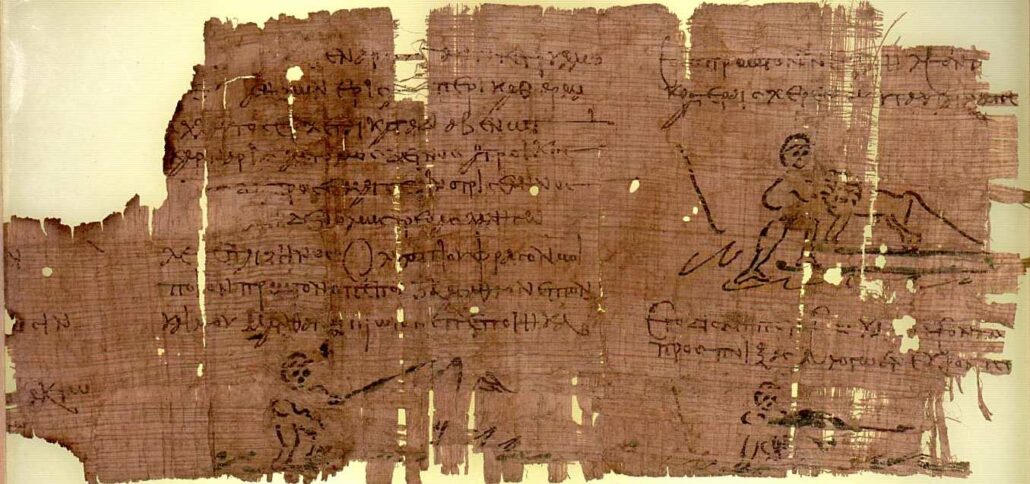
Papyrus (P. BM EA 10591 recto column IX, beginning of lines 13–17) foundation of modern paper. Image: Wikimedia
A scroll is usually divided up into pages, which are sometimes separate sheets of papyrus or parchment glued together at the edges, or may be marked divisions of continuous roll of writing material. The scroll is usually unrolled, so that one page is exposed at a time, for writing or reading, with the remaining pages rolled up to the left and right of the visible page. It is unrolled from side to side, and the text is written in lines from the top to the bottom of the page. The letters may be written left to right, right to left. Some scrolls may have wooden rollers on each end.
Hieroglyphs
Hieroglyphs was a formal writing system used by the ancient Egyptians that contained the combination of logo graphic and alphabetic elements.

Ancient Egyptian hieroglyphs or signs. Image via Pinterest
Hieroglyphs emerged from the pre-literate artistic traditions of Egypt. For example, symbols on Gerzean pottery from Circa 4000 B.C. resemble hieroglyphic writing. They refer to the characters made by graphical figures. Ancient egyptians used cursive hieroglyphs for religious literature on papyrus and wood.
Hieroglyphs consist of 3 kinds of glyphs: Phonetic glyphs, including single hyphen consonant characters that functioned like an alphabet; logographs, representing morphemes; and determinatives, which narrowed down the meaning of a logo graphic of phonetic words.
Cuneiform
Cuneiform script is a pictographic form of writing. It emerged in the Sumerian civilization of southern Iraq around the 34 century B.C.

Cuneiforms on a solid stone slab. Image via PinterestThe cuneiform writing system was in use for more than thirty centuries, through several stages of evolution. It consists of a combination of logo phonetic, consonantal alphabetic and syllabic signs. The writing direction was changed to left to right in horizontal rows, and a new wedge-tipped stylus was used which was pushed into the clay, producing wedge-shaped signs; these two developments made writing quicker and easier. By adjusting the relative position of the tablet to the stylus, the writer could use a single tool to make a variety of impressions.
Codex
A codex is a book in the format used for modern books, with separate pages normally bound together and given a cover.
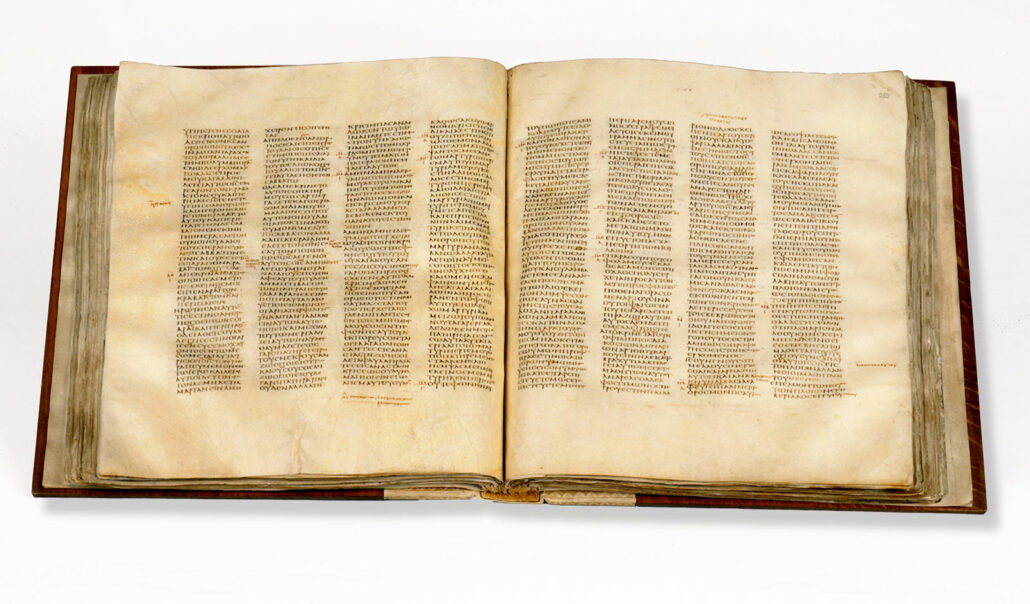
A historic codex book. Image via Britannica
The basic form of the codex was invented in Pergamon in the third century BCE. The codex also made it easier to organize documents in a library because it had a stable spine on which the title of the book could be written. The spine could be used for the incipit, before the concept of a proper title was developed. Most early codices were made of papyrus, which was fragile. The only place where papyrus grew and was made into paper, became scanty; the more durable parchment and vellum gained favour, despite the cost. It was a roman invention that replaced the scroll.
Printing Came of Age
Woodblock
Woodblock printing is a technique for printing text, images or patterns used widely throughout east Asia and originating in china in antiquity as a method of printing on textiles and later paper.

Ancient Egyptian hieroglyphs or signs. Image via MOMA
The wood block is prepared as a relief matrix, which means the areas to show “white” are cut away with a knife, chiseled or sandpaper leaving the characters or image to show in black at the original surface level.
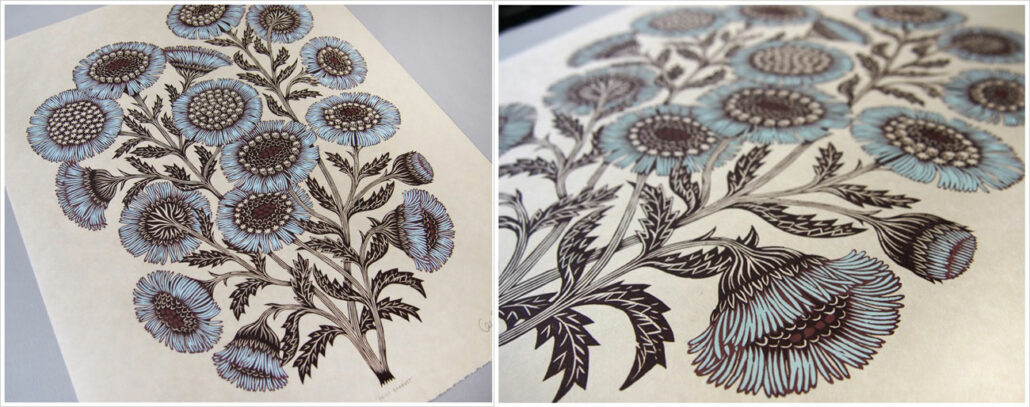 Ancient Egyptian hieroglyphs or signs. Image via MOMA
Ancient Egyptian hieroglyphs or signs. Image via MOMA
The art of carving the woodcut is technically known as xylography. The earliest surviving examples from china date to before 220 A.D. Woodblock printing in china is strongly associated to Buddhism relative to charms and sutras.
Woodcut
Woodcut is a relief printing artistic technique in printmaking in which an image is carved into the surface of a block of wood, with the printing parts remaining level with the surface while the non-printing parts are removed typically with gouges.
 Utagawa Hiroshige’s First Station: Shinagawa (品川), Forty-Eighth Station: Sakanoshita (坂ノ下). Images via Pinterest
Utagawa Hiroshige’s First Station: Shinagawa (品川), Forty-Eighth Station: Sakanoshita (坂ノ下). Images via Pinterest
The areas to show white are cut away, with the help of a knife or chisel, leaving the characters or image to show in black at the original surface level. The block is cut along the grain of wood. The surface is covered with ink by rolling over the surface with an ink covered roller (brayer) leaving ink upon the flat surface but not in the printing areas. Different blocks are used for printing various colors.
Gravure
Gravure, also known as intaglio is another form of printing that has its roots in 15th century Europe.
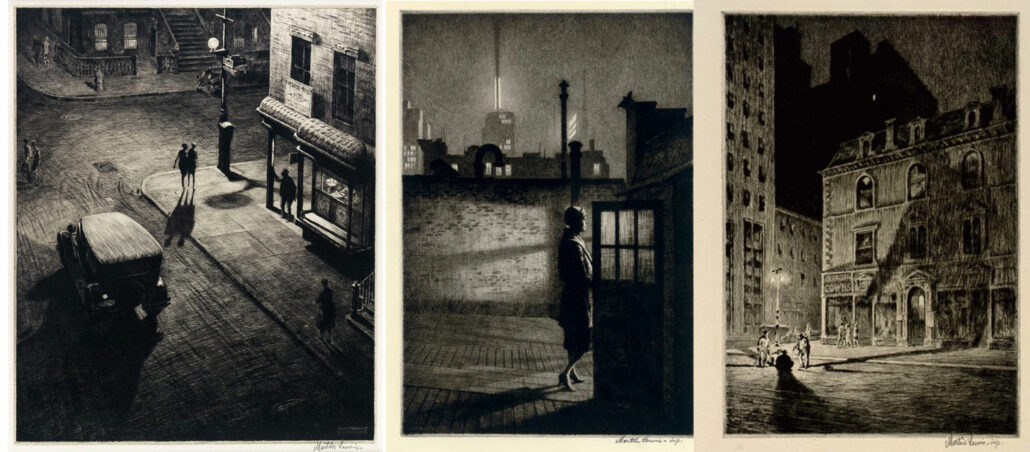 Artist Martin Lewis’ intaglio print during the renaissance period in Europe. Image via Blenderartists.org
Artist Martin Lewis’ intaglio print during the renaissance period in Europe. Image via Blenderartists.org
It is a process that involves etching an image onto the surface of a plate which is then inked and wiped clean, leaving ink only in the recessed areas. When printed under pressure, the paper draws the ink out of the engraved areas, transferring the image onto paper.
Gravure evolved over the years to accommodate multi-color printing at high speeds; it results in high grade image production. It is an industrial printing process mainly used for the high- speed production of large print magazines, and runs at a constant and top quality.
Manuscripts
An illuminated manuscript is a manuscript in which text is supplemented by the addition of decoration. Such as decorated initials, borders and miniature illustrations.

Illuminated Jain manuscript from medieval India. Image via Pinterest
To make the manuscript, the text was usually written first. Sheets of vellum, animal hides, were cut down to the appropriate size. After the general layout of the page was planned, the page was lightly ruled with a pointed stick, and the scribe went to work with ink-pot and either sharpened quill feather or reed pen.
Manuscripts using all upper-case letters are called majuscule, those using all lower case are called miniscule. They were very popular during the middle ages.
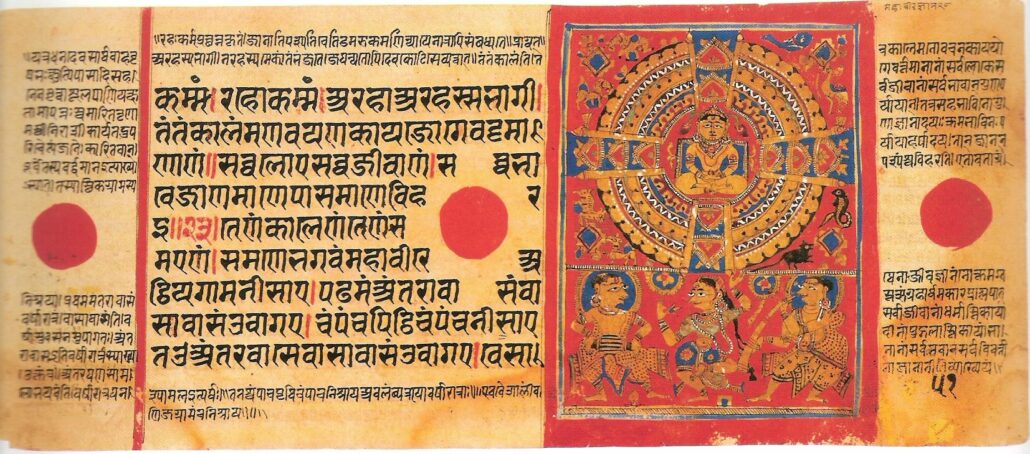
The Letterpress
Printing is a term for the relief printing of the text an image using the press, with a type-high bed. Printing press and movable type in which the reversed raised surface is in. and then pressed into a sheet of paper to obtain a positive right reading image.
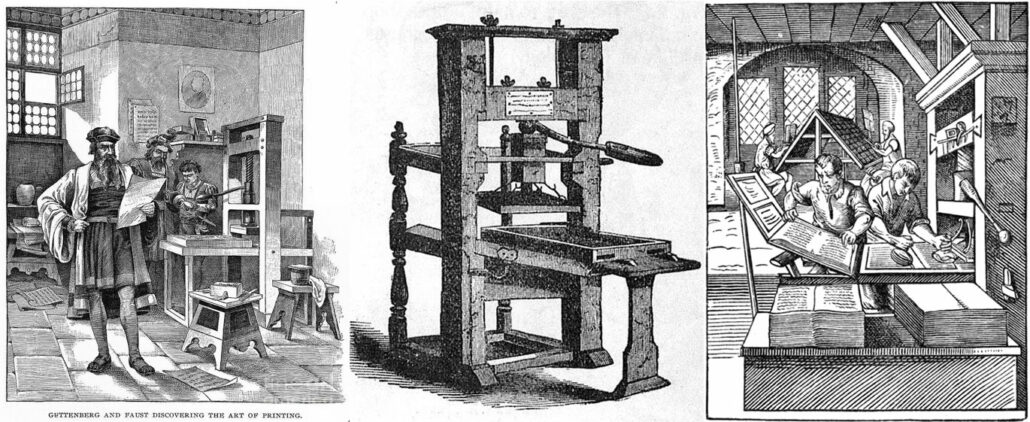 Legendary renaissance print-maker Johannes Gutenberg with his team and his machine. Images via Google
Legendary renaissance print-maker Johannes Gutenberg with his team and his machine. Images via Google
It was the normal form of printing text in the west from its invention by Johannes Gutenberg in the mid 15th century until the 19th century and remained in wide use for books and other uses until the second half of the 20th century.
In the case of letterpress printing, each page of type is used as the mold for a papier-mache mat, which is actually a copy in reverse of that page of type. The mold in turn is used to make a metal copy of the entire page, and this metal copy is used for printing.
This was the traditional way to print newspapers. Variations of this printing technique may use plastic or rubber plates. Because several plates can be made from each original, brand new type can be introduced at regular intervals, ensuring that copies remain sharp and clear.
 Gutenberg’s printing press machine also known as the letterpress. Image via Pinterest
Gutenberg’s printing press machine also known as the letterpress. Image via Pinterest
Guttenberg fitted four pieces of wood around the letter-shaped hollow, called a matrix, to form an open box. He then poured molten metal into the box, allowing it to fill up the matrix. After the metal had cooled and hardened, the sides of the box were removed, leaving a small block with the letter in relief.
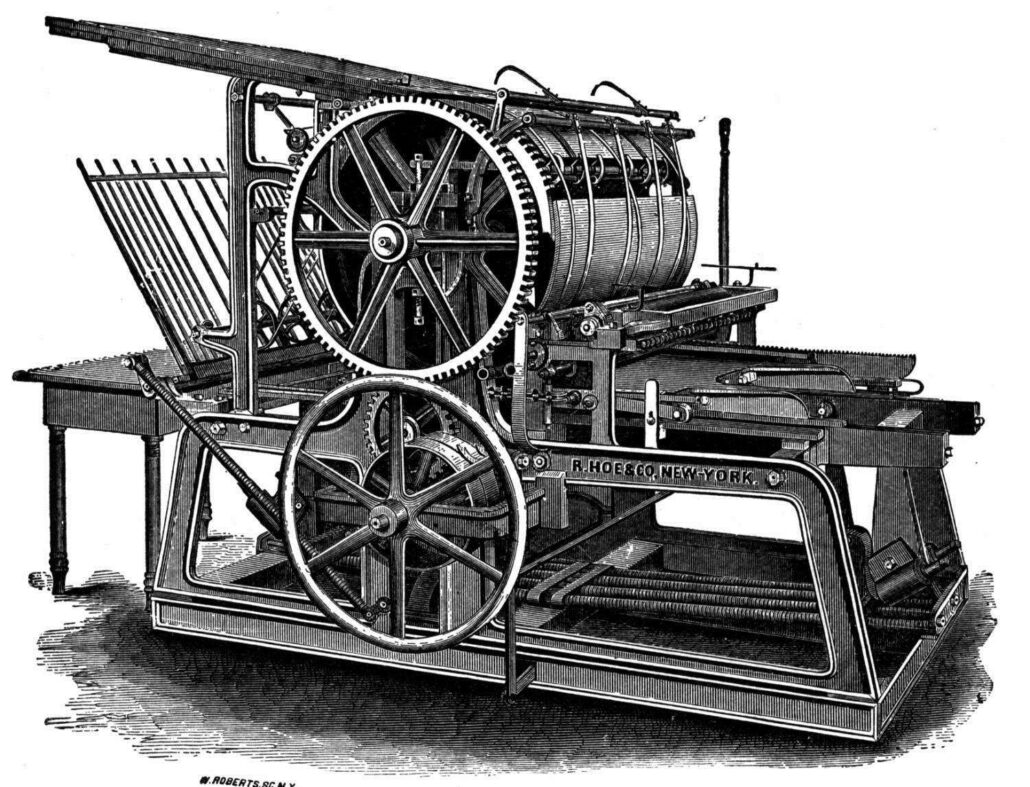 Gutenberg’s printing press machine also known as the letterpress. Image via Pinterest
Gutenberg’s printing press machine also known as the letterpress. Image via Pinterest
He, then reassembled the box to produce as many copies of each letter as he needed. The walls of the box formed a mold that could be adjusted to fit all letters. This mold made possible the development of a less expensive and faster method of printing than had previously been in use.
The best metal for the movable type was a mixture of lead, tin, and antimony. This alloy had the advantage that it did not shrink when cooled, so all letters resembled the original matrix, and the pieces of type could be linked in rows.
Type was stored in cabinet drawers, called cases. Each case held a complete set of type in a particular style and size, called font. It was the convention for printers to keep their capital letters, now referred to as upper-case letters, separate from their small, or lower-case letters.
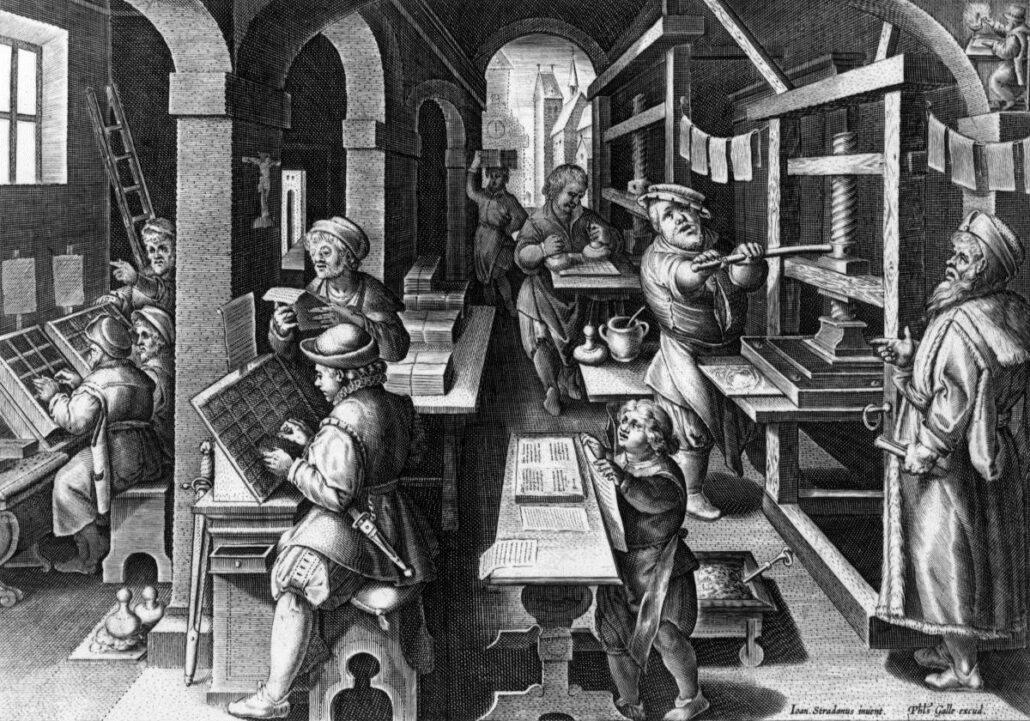 Ancient Egyptian hieroglyphs or signs. Image via Pinterest
Ancient Egyptian hieroglyphs or signs. Image via Pinterest
Letters were removed from the type case, and arranged in rows in a small metal tray. Space bars were inserted to adjust the width of the line. Filling out a line became known as justification.
When the metal tray had been filled with justified lines, the lines were transferred to a larger metal tray called a galley. The galley was inked when the printer had made sure that there were no mistakes in the set type. The printed sheet of paper that was produced became known as the galley proof.
The Gutenberg Bible
The first book of any note to be printed with movable type was Gutenberg’s bible, published in 1456. Printed in Latin, its pages consist of two columns of type, each 42 lines long. It is 1282 pages long.
In producing this book, the type was arranged on each page, and inked before the paper was pressed down on it. After removing the sheet of paper, the type would then have been re-inked before another sheet of paper was placed on it.
Gutenberg printed about 200 bibles in a five-year period. Each of the printed characters in the bible was made to resemble handwriting. Because the type in the Gutenberg bible makes the printed page very dark, it is called black letter. It has wide mrgins and the pages are well designed.
As compared with the traditional water-based ink used in manuscripts, Gutenberg had to develop a new kind of ink, an oil based on carbon, with high metallic content, including copper, lead and titanium.
“It is a press, certainly, but a press from which shall flow in inexhaustible streams…. through it, god will spread his word. A spring of truth shall flow from it: like a new star it shall scatter the darkness of ignorance, and cause a light heretofore unknown to shine amongst men” – JG
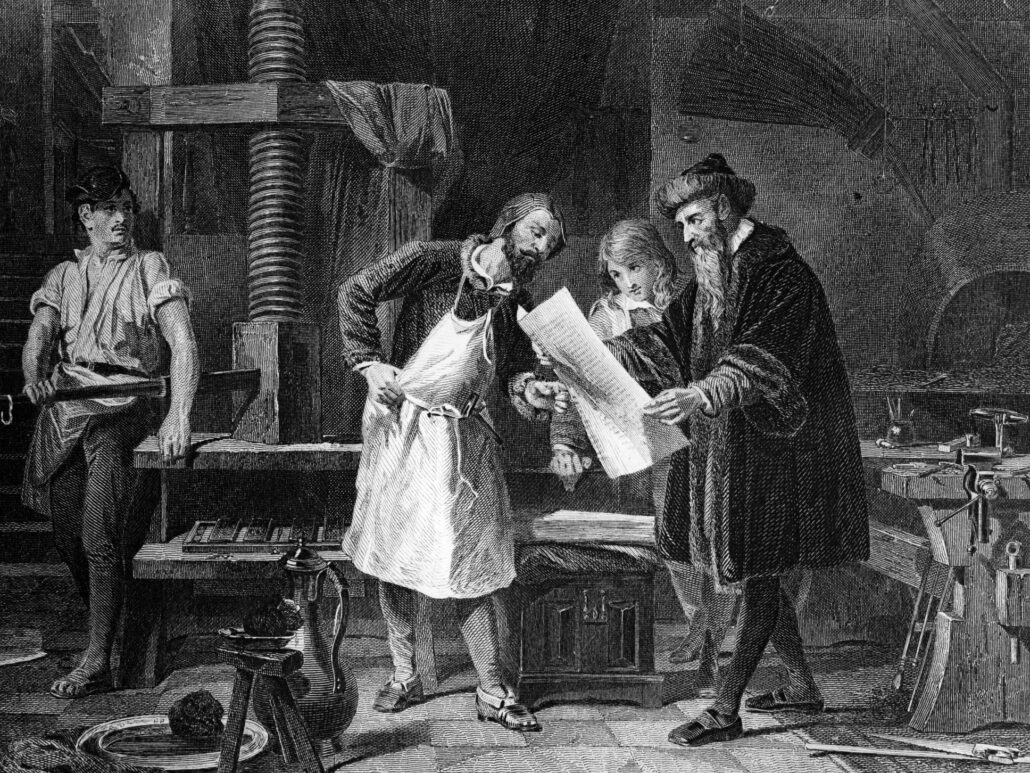 Ancient Egyptian hieroglyphs or signs. Image via Pinterest
Ancient Egyptian hieroglyphs or signs. Image via Pinterest
Lithography
“Lithography (which means “stone-writing) is based on the principle that water and grease do not mix. Ink is applied to a smooth, flat surface, such as a metal plate or stone, on which the image to be printed is ink-receptive. Because ink is oily, applying water to the blank areas of the surface makes them ink-repellent.
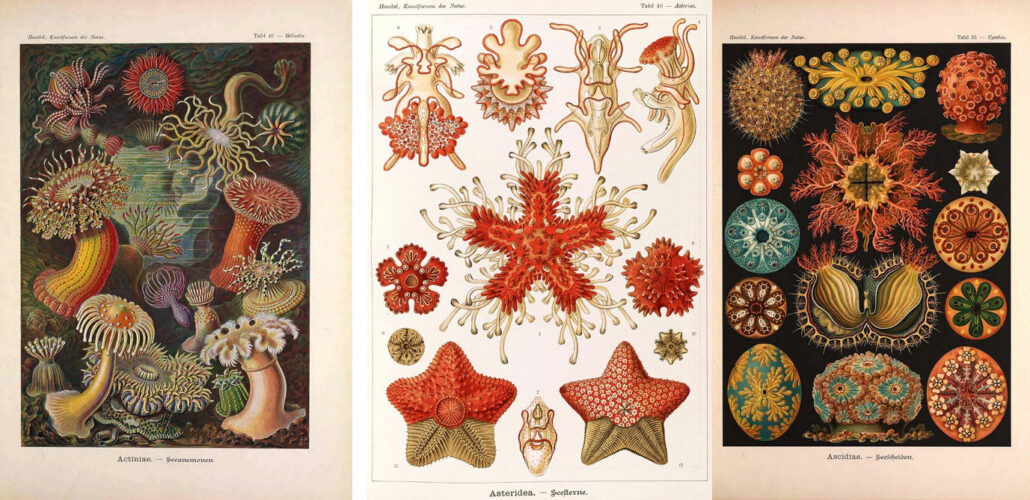 Sea anemones by Ernest Haeckel, prints of nature and sea. Images via Pinterest
Sea anemones by Ernest Haeckel, prints of nature and sea. Images via Pinterest
Aloys Senefelder, a Bavarian author, invented lithography in the late eighteenth century. Lithography can be used to print text or artwork onto paper or another suitable material. It grew during the nineteenth century as a means of printing color and imagery, and was used widely for printing posters, newspapers and magazines. Today this method is used to produce posters.
In lithography, a picture is drawn on a smooth flat stone with a special type of oily crayon. Then the lithographer passes a water-soaked roller over the stone. The water adheres to the bare stone surface, but does not stick to the oily crayon marks.
Another roller soaked with printer’s ink is passed over the stone, Since the ink will not mix with water, it cannot stick to the wet stone, but does stick to the oily crayon marks. When a sheet of paper is pressed against the inked stone, the paper takes up ink only from the places where the crayon lines are. This produces a print of the original drawing on paper.
Photolithography
It is a variation of lithography performed by machine and using a camera. It is also known as offset printing.
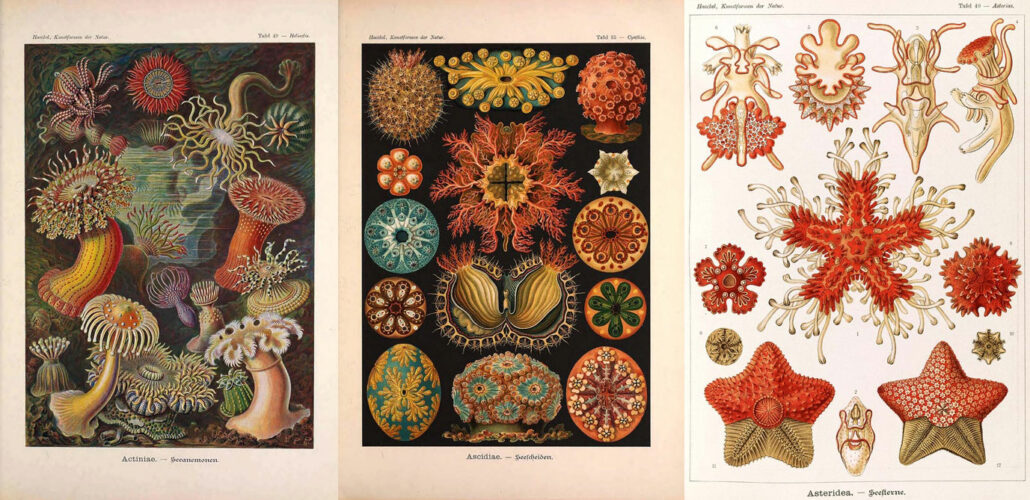
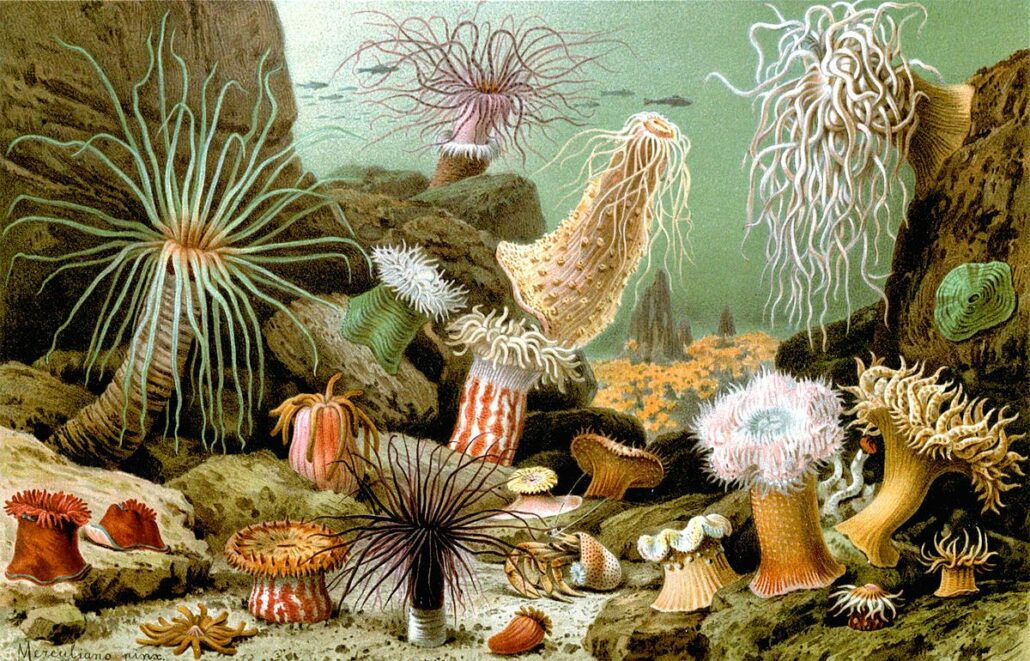
In this case, a zinc plate is used instead of stone. The picture is placed on the plate by photographic means rather than by hand. Characters and words can also be printed on the plate. The zinc plate is then curved around the printing cylinder.
As the cylinder turn, the plate first presses against a wet roller, and then against a wet roller, and then against the ink roller. This has the effect of covering the blackened portions of the plate with ink. The inked plate next rolls against a rubber-blanketed cylinder so that the image is picked up. The blanketed cylinder then transfers the image to the paper.
Techno-Print
The ability to print type has evolved rapidly in the past 100 years. Although the hand arrangement of metal type as part of letterpress printing continued well into the twentieth century, other methods of mechanical typesetting also came into use.
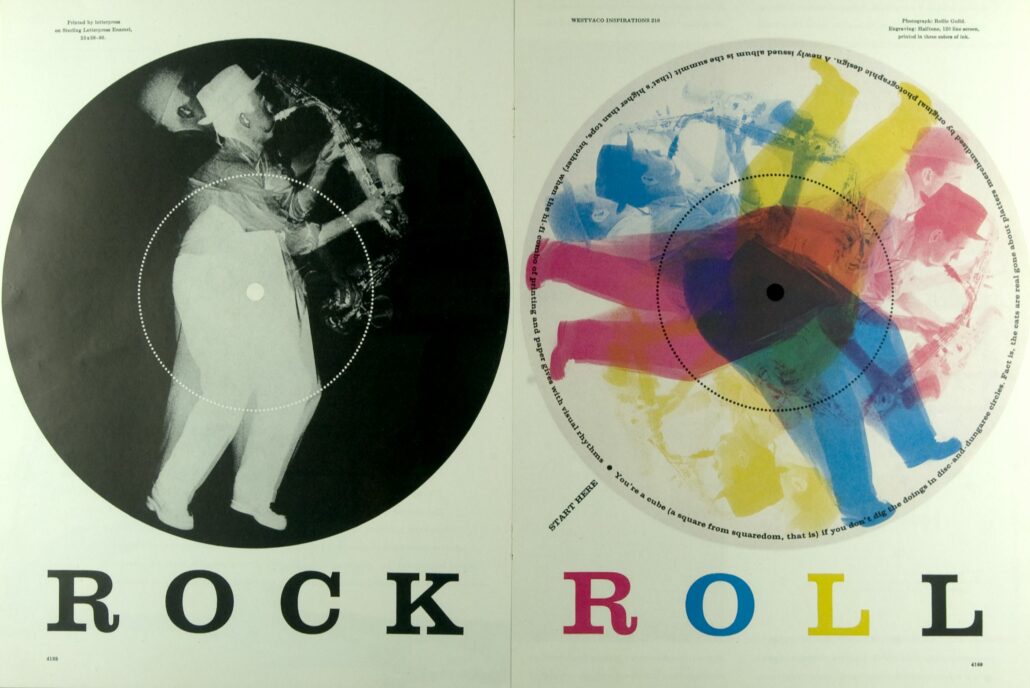
Designers such as Bradbury Thompson made their mark on the industry by introducing new imaging techniques and innovative typographic treatments. Image via Pinterest.
In the early part of the century, line casting machines, such as linotype increased efficiency over handset type by allowing users to cast lines of type. Called “slugs,” rather than individual characters. Its revolutionized printing and especially newspaper publishing. The name of the machine comes from the fact that it produces an entire line of metal type at once, hence a line-o-type.
As technological advances made type-setting and the printing of color and imagery much easier, publishing began to flourish. The early half of the twentieth century saw American magazines, (such as the Saturday evening post and harper’s bazaar from 1934 until 1958) which forged new territory with magazine layouts that incorporated lots of white space and type as shape.
Phototypesetting
Phototypesetting machines allowed type to be projected onto paper or film, which was then pasted down onto a board along with imagery and other graphic elements.
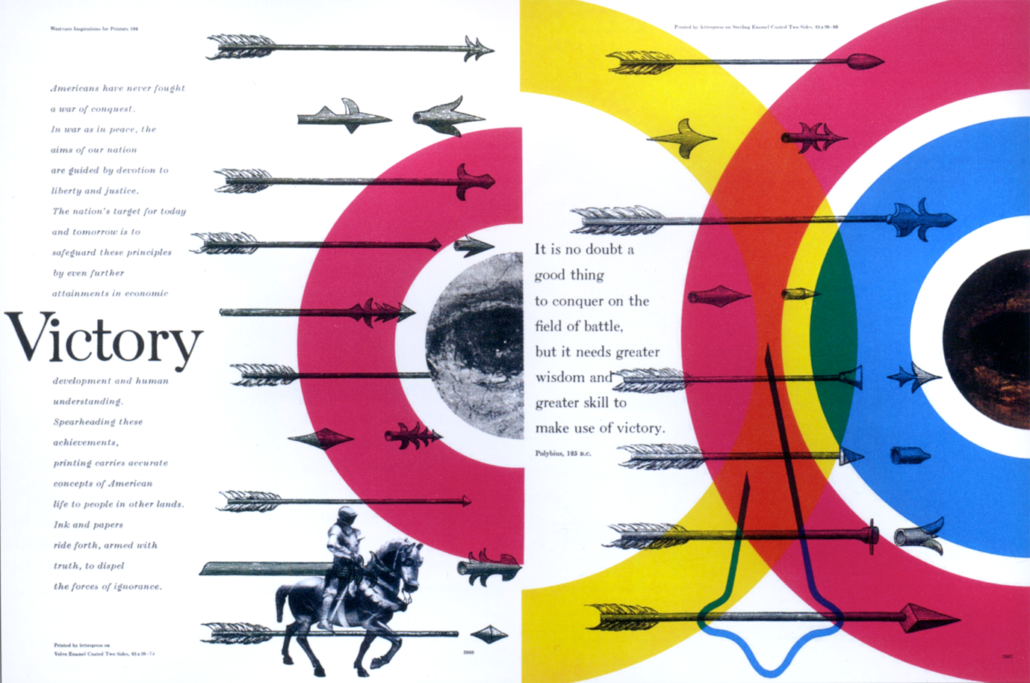 The works of Sir Bradbury Thompson. Image via Pinterest.
The works of Sir Bradbury Thompson. Image via Pinterest.
In addition to begin more efficient and economical, it was also an affordable means of producing type in-house, giving designers more flexibility to format & adjust type themselves.
In the early 1980’s personal computers such as apple Macintosh gave designers even more control over the typesetting process by allowing them to manipulate type and create their own typographic designs. The computer allowed designers to reshape letterforms, layer type, configure it into shapes and curved paths, and otherwise make it conform to a designer’s concept in ways that it had never been made to conform before.
In addition to giving designers total creative control over typography and imagery, the computer revolutionized the way publications and other printed projects are designed and produced.

